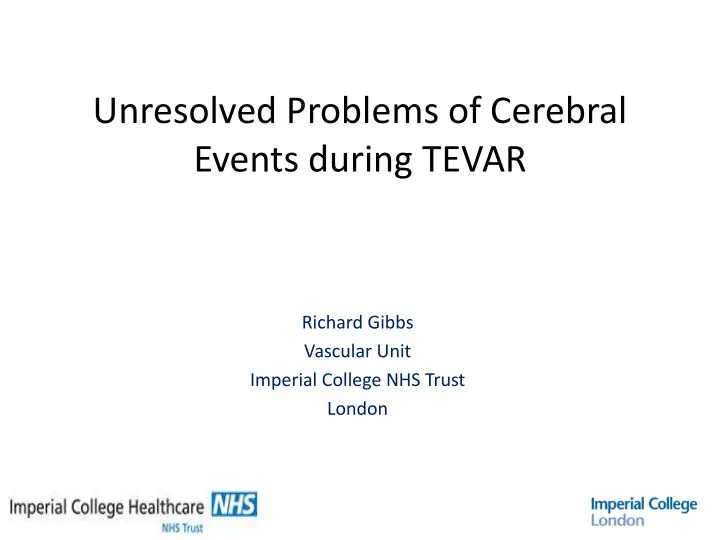

Unresolved Problems of Cerebral Events during TEVAR Richard Gibbs Vascular Unit Imperial College NHS Trust London
Disclosures • Research support from GORE Medical
Brain Injury in TEVAR Motor deficits Stroke 8% Delirium Cognitive changes ‘Silent’ stroke 70%
‘Universal and unambiguous definitions of stroke and neurovascular events become of paramount importance to understanding the etiology of Procedural Stroke: stroke in TEVAR procedures’ 1. Overt CNS Injury 2. Covert CNS Injury 3. Neurological dysfunction without CNS injury Neurologic Academic Research Consortium 2017
What has the data told us so far? �
1. TEVAR is associated with cerebral infarction
TEVAR N=52 Median age 69 Neurocognitive TCD DW-MRI assessment N=42 N=31 N=17 88% 100% 13% Stroke Decline 6/7 HITS 68% SCI domains age>69 • REY auditory verbal test, verbal learning and memory Median infarct volume Maximum HITS • Trail A – visual search and motor • Stent deployment 62 (IQR 35-192) 164mm 3 Trail B – mental flexibility & switching Contrast injection 62 (IQR 22-163) IQR (108.64-1328.30mm 3 ) • Grooved pegboard – fine motor skills • COWA (FAS) – executive function
Observational study: 77 patients DW-MRI St Thomas’ Hospital and St Mary’s Hospital Zone 2 79% (22/28) Zone 1 (6/28 stroke 22%) 77% ( 7/9) (22% 2/9 stroke) Zone 3 62% (13/21) Zone 0 (2/21 stroke 10%) 100% ( 6/6) (50% 3/3 stroke) Zone 4 39%( 5 /13) (0/13 strokes 0%)
Single unilateral large lesions VASCULAR BRAIN INFARCTS (VBI) Multiple unilateral lesions Bilateral small lesions
2. TCD provides a procedural time stamp for embolization Pre-operative Wire/catheter exchange Stent graft deployment
TCD provides a procedural time stamp for embolization
3. TCD HITS Relate To Cerebral Outcomes
4. Particulate cerebral embolization can be reduced….. CEPD reduced both number and size of new infarcts Median no particles in filters: 937 (146-1687)
…but all 3 supra -aortic trunks need protection Protected 7/9 (78%) 23 new lesions Total SA= 379mm2 Median SA= 6mm2 (3-16) Unprotected 9/12 (75%) 55 new lesions Total SA= 1534mm2 Median SA= 16mm2 (3-103)
5. TCD embolic differentiation software shows the major component of embolization is gaseous Maximum proportion of SOLID HITS – Wire& pigtail 13% , Stent deployment 11%
6. Gaseous embolization is associated with DWI- MRI infarcts Number of new MRI lesions vs gaseous HITS
3. Inflate dryseal 2. 1cm of Ctag 1. Insert Ctag into VALVE port with 5ml exposed Dryseal saline 6. Remove CTAG from 5. Saline flush into dryseal 4. Connect dryseal FLUSH dryseal and leave submerged port and guidewire lumen port to CO2 tubing under saline in tray port
Observational TEVAR-De-airing C0 2 Study Pre-operative investigations: -CT aortogram (standard work-up) -3T Brain MRI -Neurocognitive testing & Neurology - MMSE ( + depression HADS score) TEVAR With CO2 flushing 2L/min 2.8bar -Transcranial doppler (TCD) solid/ gas differentiation -Zone 2-4 TEVAR Post-operative investigations: -3T Brain MRI -Neurocognitive testing MMSE(HADs) Outpatient investigations: -Neurocognitive testing MMSE (HADs) -Neurological exam
Saline (n= 77) CO2 (n=28) P value Urgency 65% (50/77) 89% (25/28) Elective 35% (27/77) 11% (3/28) 0.015 Emergency Pathology 23% (18/77) 11% (3/28) 0.151 TAA 20% (15/77) 50% (14/28) 0.002 TAAA 13% (10/77) 0% (0/28) 0.059 DTA 14% (11/77) 4% (1/28) 0.175 TBD 8% (6/77) 18% (5/28) 0.158 CTBD 7% (5/77) 4% (1/28) 1.000 Coarctation pseudoaneurysm 12% (9/77) 11% (3/28) 1.000 PAU 10% (8/77) 4% (1/28) 0.439 Mycotic 4% (3/77) 0% (0/28) 0.563 Trauma Operation 51% (39/76) 64% (18/28) 0.238 TEVAR 8% (6/76) 14% (4/28) 0.453 TEVAR+ scallop/fenestration 21% (16/76) 4% (1/28) 0.037 TEVAR+ LSA 15% (11/76) 14% (4/28) 1.000 TEVAR+ arch hybrid 1% (1/76) 4% (1/28) 0.468 TEVAR+ F/BEVAR 1% (1/76) 0% (0/28) 1.000 TEVAR+visceral hybrid Zone 8% (6/77) 11% (3/28) 0 0.698 12% (9/77) 4% (1/28) 1 0.283 36% (28/77) 14%(4/28) 2 0.030 27% (21/77) (13/28) 3 0.064 17% (13/77) 25% (7/28) 4 0.349
Saline (n= 77) CO2 (n=28) P value Cerebral infarction 69% (53/77) 38% (9/24) 0.006 on MRI ‘Silent’ stroke 52% (40/77) 25% (6/24) 0.021 Stroke 17% (13/77) 13% (3/24) 0.756 Neurocognitive Ongoing follow-up Ongoing follow-up - assessment
INTERCePT GP : INTERvention with Cerebral Embolic Protection in TEVAR: Gaseous Protection ClinicalTrials.gov Identifier: NCT03886675 l.hanna@ic.ac.uk • RCT TEVAR-CO2 • Multi-center • Multi-graft • Standardized Saline and CO 2 de-airing techniques
Recommend
More recommend